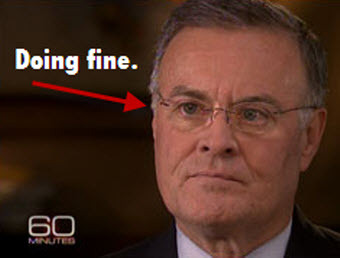On 5-Year Anniversary Of Mortgage Meltdown, Those Responsible Are Doing Just Fine

Don’t worry about former Bank of America CEO Ken Lewis, because he probably doesn’t worry about you.
In honor of the five-year anniversary of the Lehman disaster, the Center for Public Integrity has been publishing a series all week called “After the Meltdown,” which includes some follow-up looks at how various executives at failed banks and subprime lenders have survived in the post-bubble world.
First up is this rundown of CEOs at failed and bailed-out banks, former Lehman CEO Richard Fuld, who walked away from the largest bankruptcy in history with several hundred million dollars in his pocket (not literally in his pockets; no one has pants that baggy). He’s got home in Connecticut, Florida, and Idaho, and he’s now running his own consulting firm, Matrix Advisors, presumably because he’s a massive Keanu Reeves fan.
Former Bear Stearns CEO Jimmy Cayne isn’t working as hard as Fuld, though he did make around $376 million before “retiring” after Bear Stearns lost billions on toxic mortgages. Don’t expect to run into this guy at your parents’ assisted living facility, as he’s holed up in the Plaza Hotel with Heloise, playing in online bridge tournaments. The horror.
Merrill Lynch lost $8 billion under the leadership of Stanley O’Neal, but unlike Cayne he hasn’t taken to living like a wealthy retiree. Instead, he took his $165 million golden parachute and traded it for aluminum, landing a seat on the board of Alcoa.
Ken Lewis’ hubris and desire to lead the world’s largest bank resulted in Bank of America snatching up Countrywide and Merrill Lynch as they swooned. Except he didn’t really do his due diligence, or he would have seen that these two acquisitions would result in penalties, settlements, adjustments, and other costs totaling more than $40 billion. That doesn’t even factor in how BofA went from being viewed as a beloved outsider to becoming maybe the most-reviled bank in the nation in just a few years.
And yet, he walked away with around a quarter of a billion dollars. He did recently sell his home near the BofA HQ in Charlotte, NC. We can only assume it’s because current CEO Brian Moynihan kept egging Lewis’ car and writing nasty notes in shaving cream on the windshield.
Speaking of Countrywide, one might think that anyone associated with that utter disaster of a subprime lender should be unable to find a job picking up trash in Antarctica. But some Countrywide execs are doing just fine.
Countrywide co-founder Angelo Mozilo might have been the orange face of the company, but Stanford Kurland was the second in command, especially in those years when the company was lending an ungodly number of subprime, adjustable rate mortgages to anyone who could sign their name on a piece of paper.
Kurland bailed on Countrywide in 2006, shortly before all of its misdeeds became public knowledge, and after he reportedly cashed in $200 million worth of stock.
While his former employer was being pelted with rotten tomatoes in 2009, Kurland and other top Countrywide execs were quietly forming a Countrywide clone called PennyMac, which buys up loans from sales offices, bundles them and sells off the slices. Let’s just hope it’s being more transparent about the quality of those loans than Countrywide was.
Regardless, in addition to the hundreds of millions he took home when leaving Countrywide, Kurland is making several million a year at PennyMac.
This second round-up shows where Kurland and other top execs from the 25 biggest subprime lenders are now working. Hint: Most of them are just doing more subprime lending, which just goes to show that it’s hard to keep a bad banker down.
Though she’s not mentioned in the round-up, it’s worth reminding readers that Rebecca Mairone, the former Countrywide exec who ignored concerns about the lender’s efforts to write as many bad loans as possible and sell them off to Fannie Mae and Freddie Mac was later hired by Chase to run its foreclosure review department.
Want more consumer news? Visit our parent organization, Consumer Reports, for the latest on scams, recalls, and other consumer issues.

